Bathtub
How to Turn a Shower Into a Bathtub

As a homeowner, I understand the frustration of limited bathroom space and the desire for a luxurious bathtub experience. That’s why I’m excited to share with you my knowledge and expertise on how to turn a shower into a bathtub.
In this detailed guide, I’ll walk you through the steps of assessing the space, choosing the right bathtub type, and preparing the shower area for conversion.
So, let’s dive in and transform your shower into a relaxing oasis!
Key Takeaways
- Assess the space and plumbing requirements before converting a shower into a bathtub
- Consider personal preferences and needs when choosing the right bathtub type
- Properly prepare the shower area for conversion, considering plumbing and electrical requirements
- Ensure proper installation of the bathtub and surrounding materials, including waterproofing and drainage installation
Assessing the Space and Plumbing Requirements
You’ll need to measure the space in your bathroom and check the plumbing to see if it can be easily converted into a bathtub.
When it comes to plumbing considerations, it’s important to ensure that the existing pipes and drainage system are compatible with a bathtub installation. You may need to consult a professional plumber to assess the feasibility and make any necessary adjustments.
Additionally, the space utilization is a crucial factor to consider. Take into account the dimensions of the bathtub, as well as the surrounding area, to ensure there is enough room to comfortably accommodate the new fixture.
Proper planning and careful evaluation of the plumbing and space will ensure a successful conversion from a shower to a bathtub.
Choosing the Right Bathtub Type
To choose the right type of bathtub, consider your preferences and needs.
When it comes to selecting between freestanding and built-in bathtubs, there are several factors to consider.
Freestanding tubs are a popular choice for those seeking a luxurious and elegant look. They offer versatility in terms of placement, as they can be placed anywhere in the bathroom.
Built-in bathtubs, on the other hand, are more practical and space-saving. They are typically surrounded by walls or integrated into a shower enclosure.
Another important consideration is the material of the bathtub. Common materials include acrylic, fiberglass, cast iron, and stone. Each material has its own unique characteristics in terms of durability, heat retention, and maintenance.
Ultimately, the choice of bathtub type and material should be based on your personal preferences and the specific requirements of your bathroom.
Preparing the Shower Area for Conversion
When preparing the shower area for conversion, it’s important to consider the plumbing and electrical requirements. Before starting the shower pan installation, it’s crucial to ensure that the existing plumbing is suitable for a bathtub. This may involve relocating pipes or drains to accommodate the new configuration.
Additionally, electrical outlets and switches should be moved to a safe distance from the bathtub to comply with safety regulations. It’s also a good time to upgrade the electrical wiring if necessary.
As for the shower pan installation, it’s recommended to choose a durable and waterproof material, such as acrylic or fiberglass. Properly installing the shower pan is crucial to prevent leaks and ensure a solid foundation for the bathtub.
Following these bathroom remodeling tips will help create a successful and functional bathtub conversion.
Removing the Shower Components
First, it’s essential to disconnect and remove the showerhead, faucet, and any other fixtures from the shower area. This is a crucial step in converting a shower into a bathtub.
Here are the steps to remove the shower components:
-
Turn off the water supply: Locate the shut-off valves and turn them clockwise to shut off the water supply to the shower area.
-
Disconnect the fixtures: Use a wrench to loosen and remove the showerhead and faucet. Be careful not to damage the pipes or surrounding tiles.
-
Evaluate the space: Once the fixtures are removed, evaluate the space to determine if any modifications or repairs are needed. Consider the plumbing considerations, such as rerouting pipes or adding a drain for the bathtub.
Removing the shower components is the first step towards transforming your shower into a bathtub. It’s important to carefully disconnect and evaluate the space to ensure a successful conversion.
Installing the Bathtub and Surrounding Materials
When it comes to installing a bathtub and the surrounding materials, there are several key points to consider.
First and foremost, choosing the right bathtub is crucial to ensure comfort and functionality.
Secondly, waterproofing the surrounding area is essential to prevent any water damage.
Lastly, proper drainage installation is necessary to ensure that water flows smoothly and efficiently.
Choosing the Right Bathtub
To choose the right bathtub for your shower conversion, you’ll need to consider factors such as size, style, and material.
Size: Measure your bathroom space to determine the maximum dimensions your bathtub can be without overcrowding the area.
Style: Consider the overall aesthetic of your bathroom and choose a bathtub that complements the existing design. Options include freestanding, alcove, drop-in, and corner tubs.
Material: Different bathtub materials offer varying levels of durability, maintenance, and comfort. Common options include acrylic, fiberglass, cast iron, and porcelain enameled steel.
When selecting a bathtub, it’s crucial to ensure it fits your space and suits your personal preferences. Once you have chosen the perfect bathtub, you can move on to the next step, which is waterproofing the surrounding area.
Waterproofing the Surrounding Area
Once you’ve chosen the perfect bathtub, it’s important to waterproof the surrounding area to prevent any water damage.
There are various waterproofing products available that can help you achieve this. One option is to go the do-it-yourself (DIY) route and use products like waterproofing membranes, sealants, and caulk. These products are readily available at home improvement stores and can be applied easily with basic tools. However, it’s crucial to follow the manufacturer’s instructions carefully to ensure proper installation and effectiveness.
On the other hand, if you prefer a professional touch, you can hire a contractor who specializes in waterproofing. They have the expertise and experience to handle the job efficiently, ensuring a watertight seal.
Ultimately, the choice between DIY and professional installation depends on your comfort level and budget.
Proper Drainage Installation
Now that the surrounding area is properly waterproofed, the next crucial step in turning a shower into a bathtub is ensuring proper drainage installation. This is essential to prevent any water damage and ensure efficient water flow.
Here are the key points to consider:
-
Drainage slope: It is important to create a slight slope in the shower floor towards the drain. This allows the water to flow easily and prevents any pooling or standing water.
-
Waterproofing materials: Use high-quality waterproofing materials for the drain area, such as waterproof membranes or prefabricated shower pans. These materials provide an extra layer of protection against leaks and water damage.
-
Proper sealant application: Apply a waterproof sealant around the drain and any joints or seams in the drainage system. This helps to prevent any water from seeping through and causing potential damage.
By following these steps, you can ensure that your new bathtub will have proper drainage and prevent any water-related issues.
Now, let’s move on to the next step of connecting the plumbing and drainage.
Connecting the Plumbing and Drainage
When it comes to connecting the plumbing and drainage in a bathroom renovation project, there are several key points to consider.
Firstly, understanding the different types of plumbing connections and how they work is crucial for ensuring a successful installation.
Secondly, proper drainage installation is essential to prevent any future issues with clogs or leaks.
Lastly, having the right tools for plumbing tasks, such as wrenches, pipe cutters, and pliers, is necessary to ensure a smooth and efficient installation process.
Plumbing Connections Explained
To connect the plumbing for the bathtub, you’ll need to attach the drain and supply lines. Proper plumbing connections are crucial for ensuring a functional and leak-free bathtub.
Here are three common plumbing connection mistakes to avoid and troubleshooting tips:
-
Incorrect pipe sizing: Using pipes that are too small can lead to reduced water flow and clogs. Ensure that the supply and drain lines are appropriately sized for your bathtub.
-
Poor sealing: Inadequate sealing can result in water leaks and damage. Use plumber’s tape or joint compound to create a watertight seal between connections.
-
Improper alignment: Misaligned connections can cause leaks and hinder the proper flow of water. Ensure that all connections are aligned correctly and tightened securely.
Proper Drainage Installation
Proper drainage installation is essential for preventing water leaks and ensuring optimal functionality. When it comes to installing a drainage system, attention to detail is crucial.
First, it is important to determine the appropriate location for the drain. This involves considering factors such as the slope of the floor and the proximity to existing plumbing lines.
Once the location is determined, the next step is to properly prepare the area by removing any debris or obstructions.
The drain should then be securely connected to the existing plumbing lines using the appropriate fittings and connectors. It is essential to ensure that all connections are tight and leak-free.
Finally, a waterproof membrane should be installed around the drain to provide an additional layer of protection against water leaks.
Tools for Plumbing Tasks
You’ll need a variety of tools for your plumbing tasks, such as a wrench, pliers, and a pipe cutter. These tools are essential for any DIY plumbing project and will help you perform plumbing techniques with ease.
Here are the three tools you should have in your toolbox:
-
Wrench: A wrench is a versatile tool that allows you to tighten or loosen nuts and bolts. It’s essential for tasks like tightening pipe connections or removing old fixtures.
-
Pliers: Pliers come in handy for gripping and turning pipes or fittings. They provide a strong grip, making it easier to maneuver and tighten connections.
-
Pipe Cutter: A pipe cutter is necessary for cutting pipes to the desired length. It ensures clean and precise cuts, allowing for proper fitting and installation.
These tools will help you tackle any plumbing project with confidence.
Now, let’s move on to the next section, where we’ll discuss finishing touches and maintenance tips for your newly installed bathtub.
Finishing Touches and Maintenance Tips
For easy maintenance, make sure you regularly clean the bathtub and replace any worn-out seals or caulking. This will help to prevent any water leakage and keep your bathtub in good condition. In addition to regular cleaning, it is important to have a maintenance schedule to ensure that all parts of your bathtub are functioning properly. This includes checking the drain, faucets, and any other components for any signs of wear or damage. When it comes to the finishing touches, choosing decorative tiles can add a touch of elegance to your bathtub. Consider selecting tiles that complement the overall aesthetic of your bathroom. With proper maintenance and attention to detail, your bathtub can remain a functional and stylish addition to your home.
| Maintenance Tips | Finishing Touches |
|---|---|
| Regular cleaning | Choosing decorative tiles |
| Replacing worn-out seals/caulking | Complementing the overall aesthetic |
| Checking drain/faucets for wear or damage | |
| Following a maintenance schedule |
Conclusion
So there you have it, folks! Turning a shower into a bathtub is no small feat, but with the right knowledge and tools, it can be an exhilarating and rewarding project.
From assessing the space and plumbing requirements to choosing the perfect bathtub type and installing it with precision, we’ve covered it all.
Now, imagine soaking in your luxurious bathtub, surrounded by beautiful tiles and enjoying the ultimate relaxation experience. It’s like stepping into a spa right in your own home.
So go ahead, transform your shower into a bathtub and indulge in the lap of luxury!
Mateo’s flair for writing is matched only by his keen eye for design. As an interior designer turned writer, Mateo brings a unique perspective. He blends aesthetics with functionality in every piece he pens, providing readers with beautifully crafted content that’s also supremely useful.
Mateo loves exploring the latest bathroom tech trends and is our expert on smart toilets. When he’s not writing or designing, Mateo can be found sketching ideas for his next big project at local coffee shops.
Bathtub
What Makes a Toilet Less Likely to Clog

Here is what we have discovered about preventing clogged toilets:
- A good flush is key. By using proper flushing techniques, we can prevent blockages and ensure smooth operation.
- Toilet paper usage is another factor to consider. Being mindful of how much we use can make a big difference.
- Regular maintenance and cleaning also play a crucial role in preventing clogs.
- Moreover, if we avoid flushing non-flushable items and consider upgrading to a high-pressure toilet, we can further reduce the risk of clogging.
Key Takeaways
- Use the appropriate amount of water to flush waste effectively.
- Avoid flushing non-flushable items such as baby wipes, dental floss, and cotton swabs.
- Regular maintenance and cleaning of the toilet bowl, drain, and tank are essential to prevent clogs.
- Consider upgrading to a high-pressure toilet for improved flushing power and reduced likelihood of clogs.
Proper Flushing Techniques
To ensure a toilet is less likely to clog, we must use the proper flushing techniques. Water conservation during flushing plays a crucial role in preventing clogs. It’s essential to use the appropriate amount of water to flush away waste effectively without wasting excess water.
When flushing, a high water pressure is necessary to ensure efficient removal of waste from the toilet bowl. Adequate water pressure creates a strong force that helps carry away debris and prevents it from getting stuck in the drainage system. However, excessively high water pressure may lead to splashing or overflowing, which can cause clogs.
Therefore, it’s important to strike a balance between water pressure and conservation to maximize flushing efficiency while minimizing the risk of clogs.
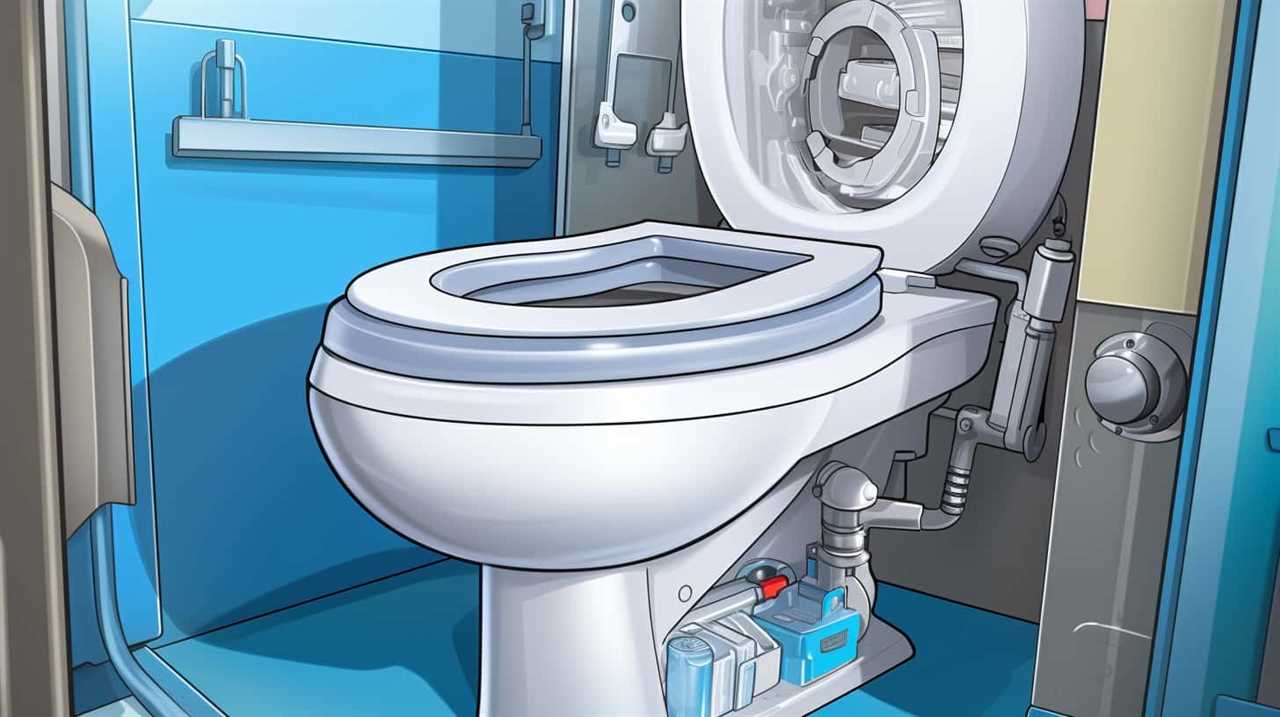
Toilet Paper Usage
When it comes to preventing clogs, our toilet paper usage is a crucial factor to consider. Not all toilet papers are created equal, and some are more prone to causing blockages than others. To help you make an informed choice, let’s analyze the environmental impact and explore alternatives to traditional toilet paper.
Toilet paper usage can have a significant environmental impact. The production of toilet paper involves cutting down trees and requires a substantial amount of water and energy. Additionally, the transportation and disposal of toilet paper contribute to carbon emissions and waste accumulation.
Considering alternatives to toilet paper can help reduce the environmental impact. Bidets, for example, provide a more hygienic and efficient way to clean oneself after using the toilet. Other options include reusable cloth wipes or bamboo-based toilet paper, which is more sustainable than traditional options.
By understanding the environmental impact of our toilet paper usage and exploring alternatives, we can make more conscious choices that are both eco-friendly and effective in preventing clogs.

Now, let’s delve into the next section about regular maintenance and cleaning.
Regular Maintenance and Cleaning
Maintaining and cleaning our toilets regularly is essential in preventing clogs and ensuring optimal performance. Neglecting this aspect of toilet care can lead to unpleasant and costly issues down the line. To keep our toilets in top shape, here are some important steps to follow:
- Toilet bowl scrubbing: Regularly scrubbing the toilet bowl removes built-up grime and prevents blockages. Use a toilet brush and a mild cleaner to thoroughly clean the bowl, paying special attention to the rim and under the rim.
- Drain inspection: Periodically inspecting the drain can help identify potential clogging issues before they become major problems. Check for any signs of blockage, such as slow draining or unusual noises. If necessary, use a plunger or a drain snake to clear any debris.
- Cleaning the tank: It’s also important to clean the toilet tank to prevent sediment buildup. Remove the tank lid and use a sponge or brush to clean the inside surfaces. Be sure to flush the tank thoroughly after cleaning.
- Regular maintenance schedule: Establish a regular maintenance schedule to ensure that cleaning and inspection tasks are performed consistently. This will help prevent clogs and maintain optimal toilet performance.
Avoiding Flushing Non-Flushable Items
One important step in preventing toilet clogs is to avoid flushing non-flushable items. Properly disposing waste and educating children about what can be flushed are crucial aspects of maintaining a functional toilet system. To emphasize the significance of this step, let’s take a look at the following table:
| Non-Flushable Items | Why They Shouldn’t Be Flushed | Proper Disposal Method |
|---|---|---|
| Baby wipes | They do not break down easily | Dispose in the trash |
| Dental floss | Can cause clogs and tangles | Throw in the trash |
| Cotton swabs | Can get stuck and form blockages | Dispose in the trash |
Disposing waste properly involves recognizing that some items, such as baby wipes, dental floss, and cotton swabs, should not be flushed down the toilet. Instead, they should be placed in the trash. Educating children about these guidelines is essential to prevent accidental flushing of non-flushable items. By following these practices, we can reduce the risk of toilet clogs and maintain a properly functioning toilet system.
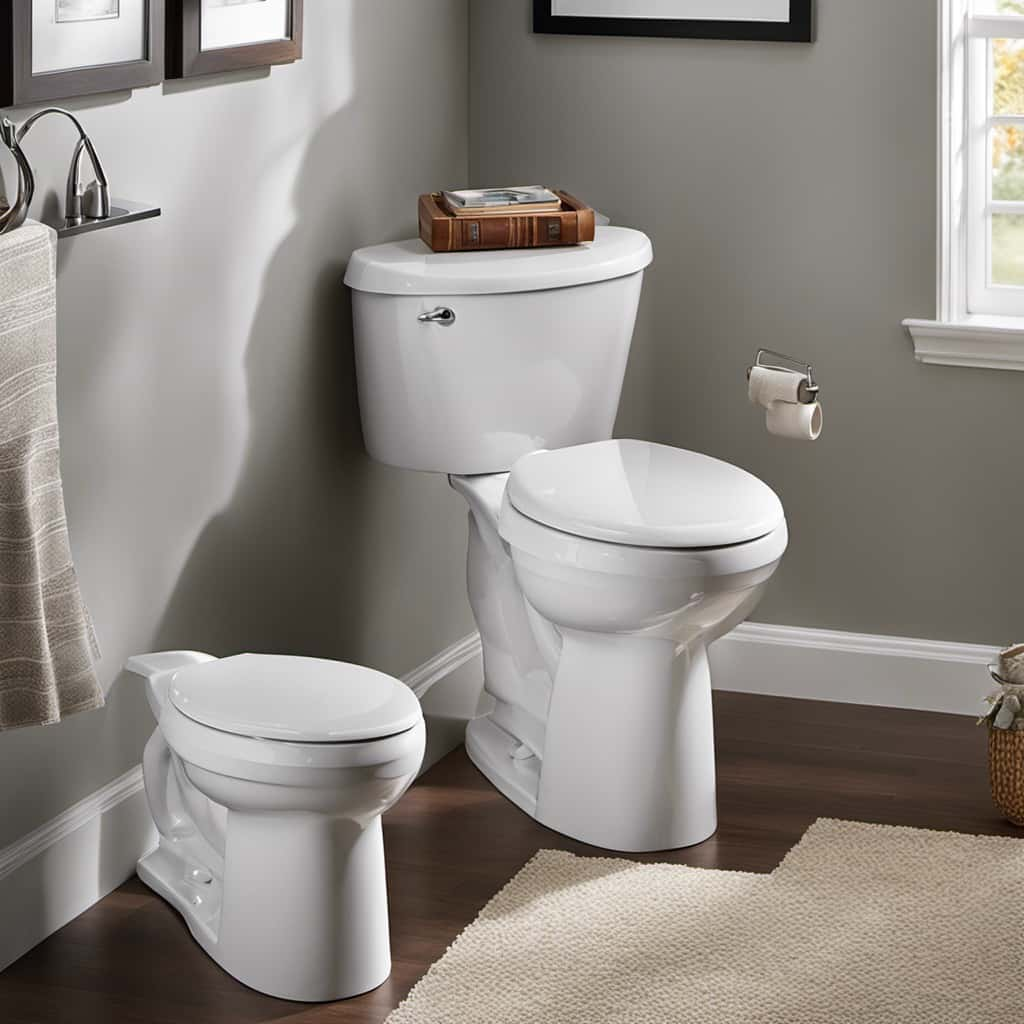
Upgrading to a High-Pressure Toilet
To reduce the likelihood of clogs, we recommend upgrading to a high-pressure toilet. High-pressure toilets are designed to provide a stronger flush, which helps to clear waste more effectively and prevent clogs from occurring.
Here are some key benefits of upgrading to a high-pressure toilet:
- Increased water pressure: High-pressure toilets are designed to operate with higher water pressure, ensuring a more forceful and thorough flush.
- Efficient waste removal: The increased water pressure helps to push waste through the plumbing system more efficiently, reducing the chances of clogs.
- Less maintenance: With a high-pressure toilet, you’ll experience fewer clogs, which means less time and money spent on maintenance and repairs.
- Improved overall performance: Upgrading to a high-pressure toilet will enhance the overall performance of your plumbing system, ensuring a more reliable and efficient flushing experience.
Frequently Asked Questions
How Do I Fix a Clogged Toilet if the Proper Flushing Techniques Mentioned in the Article Don’t Work?
If the proper flushing techniques don’t work to fix a clogged toilet, we can try other toilet unclogging techniques. One effective method is using a plunger to create suction and dislodge the blockage.
Can Using a Bidet Instead of Toilet Paper Help Prevent Clogs?
Using a bidet instead of toilet paper has several benefits, including reducing the environmental impact of toilet paper. Bidets use water to clean, which can help prevent clogs by ensuring proper flushing.

How Often Should I Hire a Professional Plumber for Regular Maintenance and Cleaning of My Toilet?
For regular maintenance and cleaning of our toilet, we should hire a professional plumber periodically. They are skilled in identifying and resolving potential issues, ensuring optimal functionality and reducing the likelihood of clogs.
What Are the Consequences of Flushing Non-Flushable Items, and How Can They Be Avoided?
Flushing non-flushable items can have serious consequences, such as clogs and damage to your plumbing system. To avoid these issues, it is crucial to educate ourselves on what can and cannot be flushed and dispose of non-flushable items properly.
Are There Any Drawbacks or Disadvantages to Upgrading to a High-Pressure Toilet?
When considering the advantages and disadvantages of upgrading to a high-pressure toilet, it is important to evaluate factors such as water consumption, noise levels, and maintenance requirements.
Conclusion
In conclusion, after investigating the truth behind what makes a toilet less likely to clog, it’s clear that proper flushing techniques, mindful toilet paper usage, regular maintenance and cleaning, avoiding flushing non-flushable items, and upgrading to a high-pressure toilet are all essential factors.

By following these guidelines, you can ensure a smoothly functioning toilet and minimize the chances of experiencing clogs. Remember, a little attention and care go a long way in maintaining a trouble-free bathroom experience.
With an impeccable eye for detail and a passion for bathroom-related, Ava leads our editorial team gracefully and precisely.
Under her guidance, Best Modern Toilet has flourished as the go-to resource for modern bathroom enthusiasts. In her free time, you might find Ava exploring antique shops and looking for vintage bathroom fixtures to add to her collection.
Bathtub
Is It Ok to Flush Condoms Down the Toilet

Let’s discuss a crucial topic: the correct way to dispose of condoms.
Flushing condoms down the toilet may seem convenient, but is it really okay? In this article, we’ll explore the potential risks and environmental impact of this practice.
We’ll also discuss the effects on plumbing systems and provide responsible alternatives for condom disposal.
Join us as we delve into this topic, aiming to inform and empower you with the knowledge you need for responsible condom use.
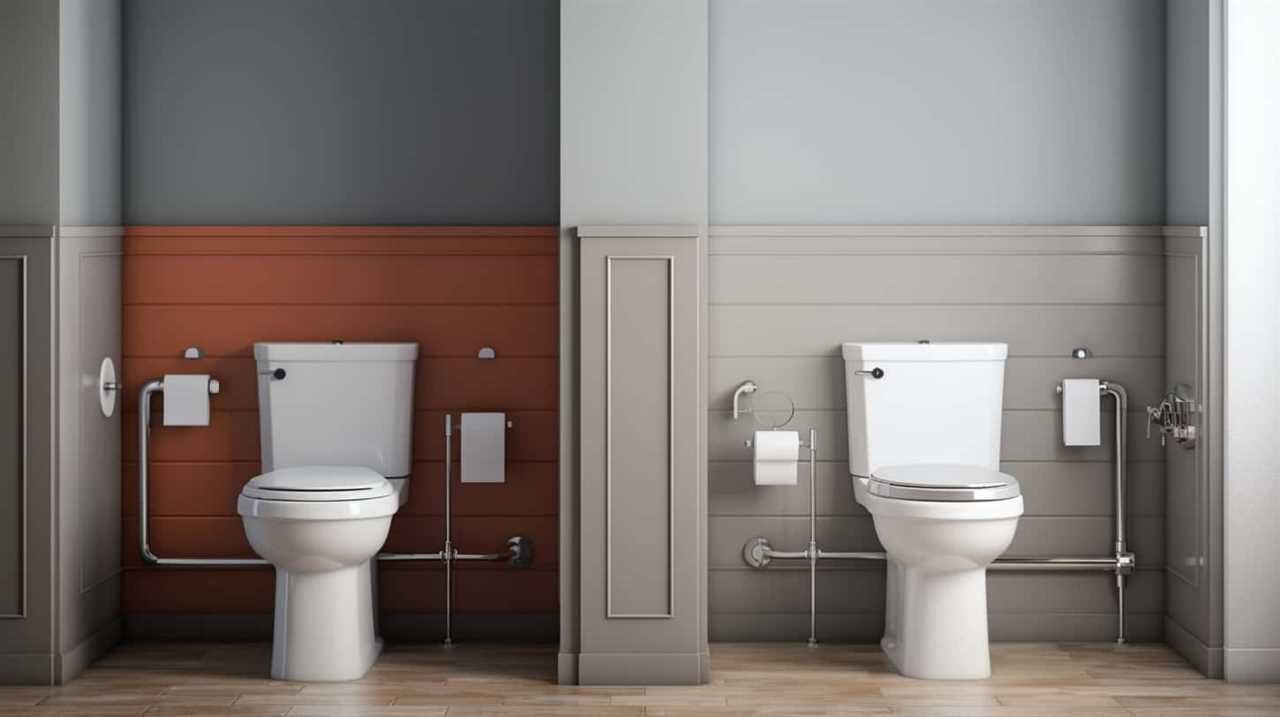
Key Takeaways
- Flushing condoms can lead to clogs and costly repairs in sewage systems.
- Flushed condoms contribute to environmental pollution in water bodies and harm marine life.
- Condoms made of latex or polyurethane are not easily biodegradable and can cause plumbing issues.
- Responsible disposal methods, such as wrapping condoms in tissue and throwing them in the trash, are essential for preventing these risks.
Potential Risks of Flushing Condoms
Flushing condoms down the toilet poses several potential risks that we should be aware of.
One of the main risks is the possibility of clogging the sewage system. Condoms are made of materials that don’t easily break down in water, such as latex or polyurethane. As a result, when flushed down the toilet, they can cause blockages in pipes and sewage treatment plants. These blockages not only disrupt the flow of wastewater, but they can also lead to costly repairs and maintenance.
Moreover, the impact on sewage systems goes beyond clogging. Condoms can end up in rivers, lakes, and oceans, contributing to environmental pollution. It’s important to properly dispose of condoms in designated waste bins to avoid these risks and protect the integrity of sewage systems.
Environmental Impact of Flushing Condoms
When condoms are flushed down the toilet, they contribute to environmental pollution by ending up in rivers, lakes, and oceans. This has significant biodegradability concerns and can have a detrimental impact on aquatic ecosystems. The materials used in condoms, such as latex and polyurethane, are not readily biodegradable and can persist in the environment for a long time. As a result, these non-biodegradable condoms can accumulate in water bodies, posing a threat to marine life. To illustrate the gravity of this issue, consider the following table:
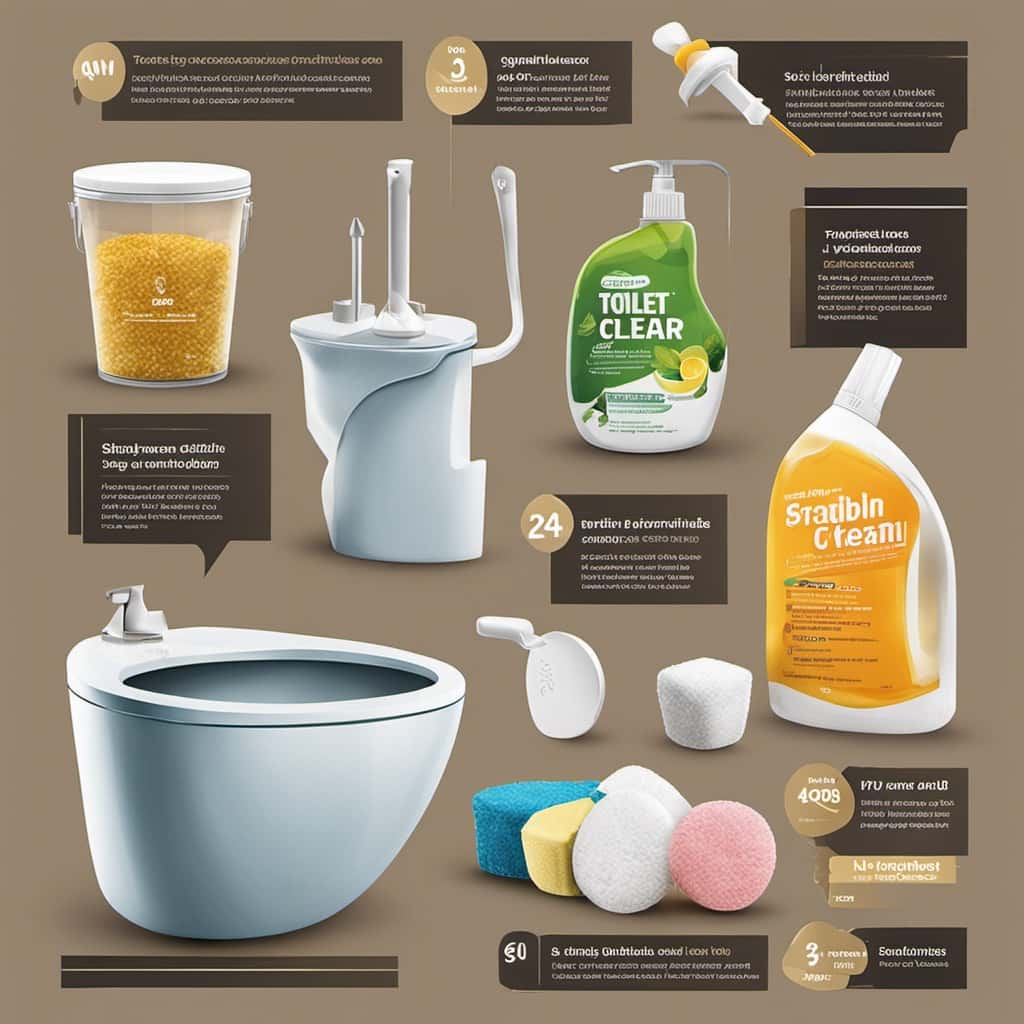
| Environmental Impact of Flushing Condoms | ||
|---|---|---|
| Condom Materials | Biodegradability | Impact on Aquatic Ecosystems |
| Latex | Not readily biodegradable | Can harm marine life |
| Polyurethane | Not readily biodegradable | Can harm marine life |
It is crucial to raise awareness about the negative consequences of flushing condoms and encourage responsible disposal methods to protect our environment.
Effects of Condoms on Plumbing Systems
As we continue our discussion on the environmental impact of flushing condoms, it’s important to consider the effects these contraceptives can have on plumbing systems.
When condoms are flushed down the toilet, they can cause various plumbing issues that may lead to clogging concerns. Condoms are made of materials like latex or polyurethane, which aren’t easily biodegradable. These materials have the potential to cause blockages in pipes, especially in older plumbing systems with narrower pipes.
Additionally, condoms can wrap around other debris in the plumbing, creating a larger obstruction. This can result in reduced water flow, backups, and even costly repairs.
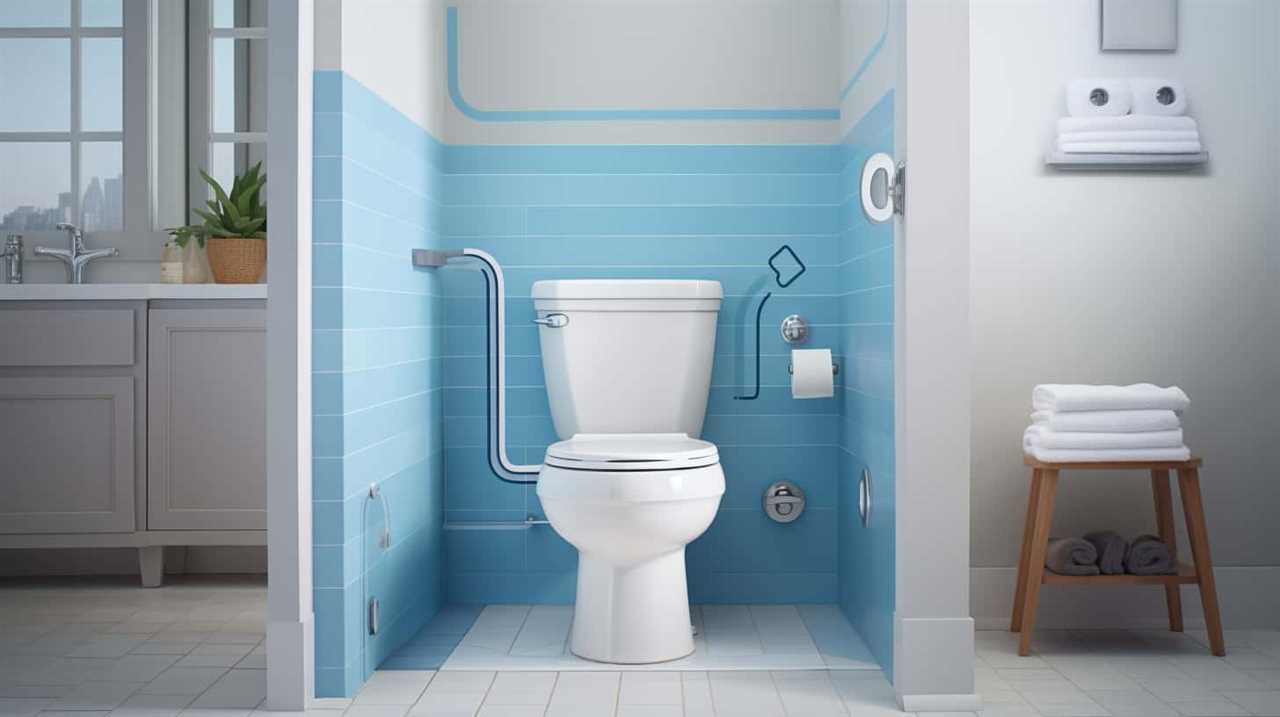
It’s crucial to dispose of condoms properly in trash bins to prevent these plumbing problems and maintain the integrity of the plumbing system.
Alternatives to Flushing Condoms
To avoid the potential plumbing issues associated with flushing condoms, we can explore alternative methods of disposal.
One sustainable condom disposal option is to wrap the used condom in tissue or toilet paper and place it in a waste bin. This prevents clogging of the plumbing system and ensures proper waste management.
Another alternative is to use biodegradable condoms. These condoms are made from materials that can break down naturally over time, reducing their environmental impact. Biodegradable condom options are becoming more widely available and offer a more eco-friendly option for disposal.

Responsible Methods of Condom Disposal
To ensure responsible condom disposal, we can continue the conversation by exploring effective methods that minimize the risk of plumbing issues and promote environmental sustainability.
Proper condom disposal is crucial to prevent blockages in plumbing systems and protect the environment.
Safe condom disposal methods involve wrapping the used condom in tissue or toilet paper and throwing it in the trash. It’s important not to flush condoms down the toilet as they can clog pipes and cause expensive damage.
Another option is to use dedicated condom disposal bags or pouches, which can be found at pharmacies or online. These bags are designed to securely hold used condoms until they can be properly disposed of in the trash.
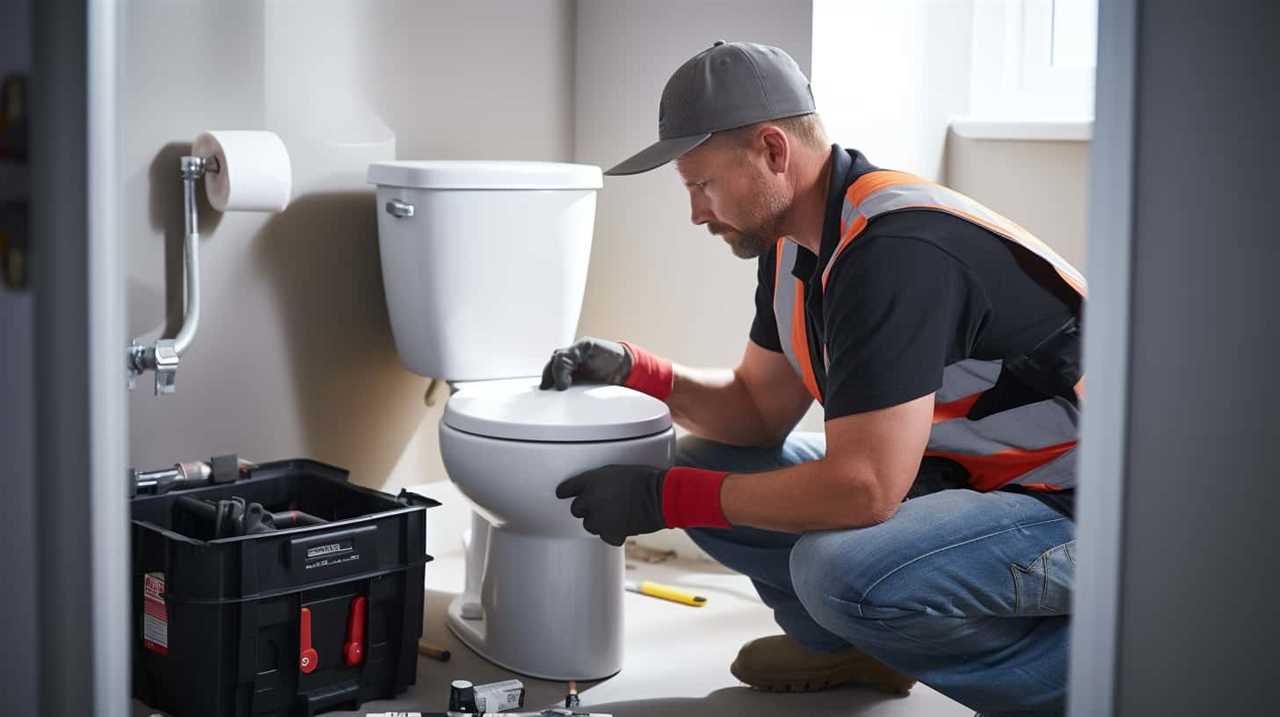
Frequently Asked Questions
Can Flushing Condoms Down the Toilet Cause Damage to the Sewage System?
Flushing condoms down the toilet can cause sewage system damage and health risks. It is important to properly dispose of condoms in the trash to prevent clogs and ensure the integrity of the sewage system.
Are There Any Health Risks Associated With Flushing Condoms?
There can be health risks associated with flushing condoms, as they can clog pipes and damage sewage systems. Proper disposal, such as wrapping them in tissue and throwing them in the trash, is recommended.
What Are the Potential Consequences of Flushing Condoms on the Environment?
Flushing condoms down the toilet can have potential pollution and environmental impact. Proper disposal is crucial to prevent clogging, sewage system damage, and harm to aquatic life. It is not recommended.
Are There Any Alternative Methods of Disposing of Condoms Besides Flushing?
When considering the proper disposal of condoms, it’s essential to explore alternative methods. Flushing condoms down the toilet may not be advisable, but there are other options available that ensure both convenience and environmental responsibility.
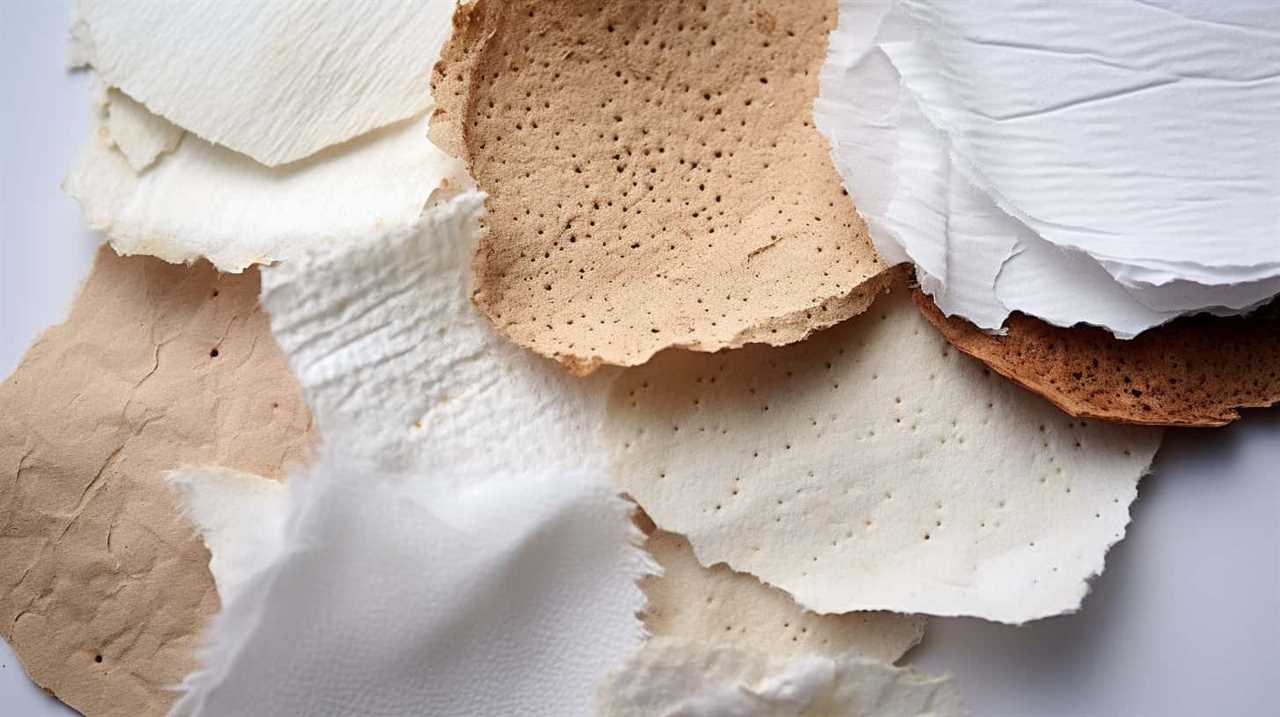
How Can Individuals Responsibly Dispose of Condoms to Minimize Their Impact on the Environment?
To minimize our impact on the environment, we must practice sustainable condom disposal. We can explore eco-friendly methods such as wrapping condoms in tissue and disposing them in the trash, or using biodegradable condom options.
Conclusion
In conclusion, it’s indeed a brilliant idea to flush condoms down the toilet! Who needs to consider the potential risks of clogged pipes, sewer backups, or the environmental impact?
Let’s just ignore the fact that condoms can wreak havoc on plumbing systems and opt for the convenient route. After all, who needs responsible methods of condom disposal when we can embrace the thrill of a plumbing disaster?
The choice is yours, but remember, sarcasm does wonders for analytical objectivity.

With an impeccable eye for detail and a passion for bathroom-related, Ava leads our editorial team gracefully and precisely.
Under her guidance, Best Modern Toilet has flourished as the go-to resource for modern bathroom enthusiasts. In her free time, you might find Ava exploring antique shops and looking for vintage bathroom fixtures to add to her collection.
Bathtub
Should I Close the Toilet Seat After Pooping
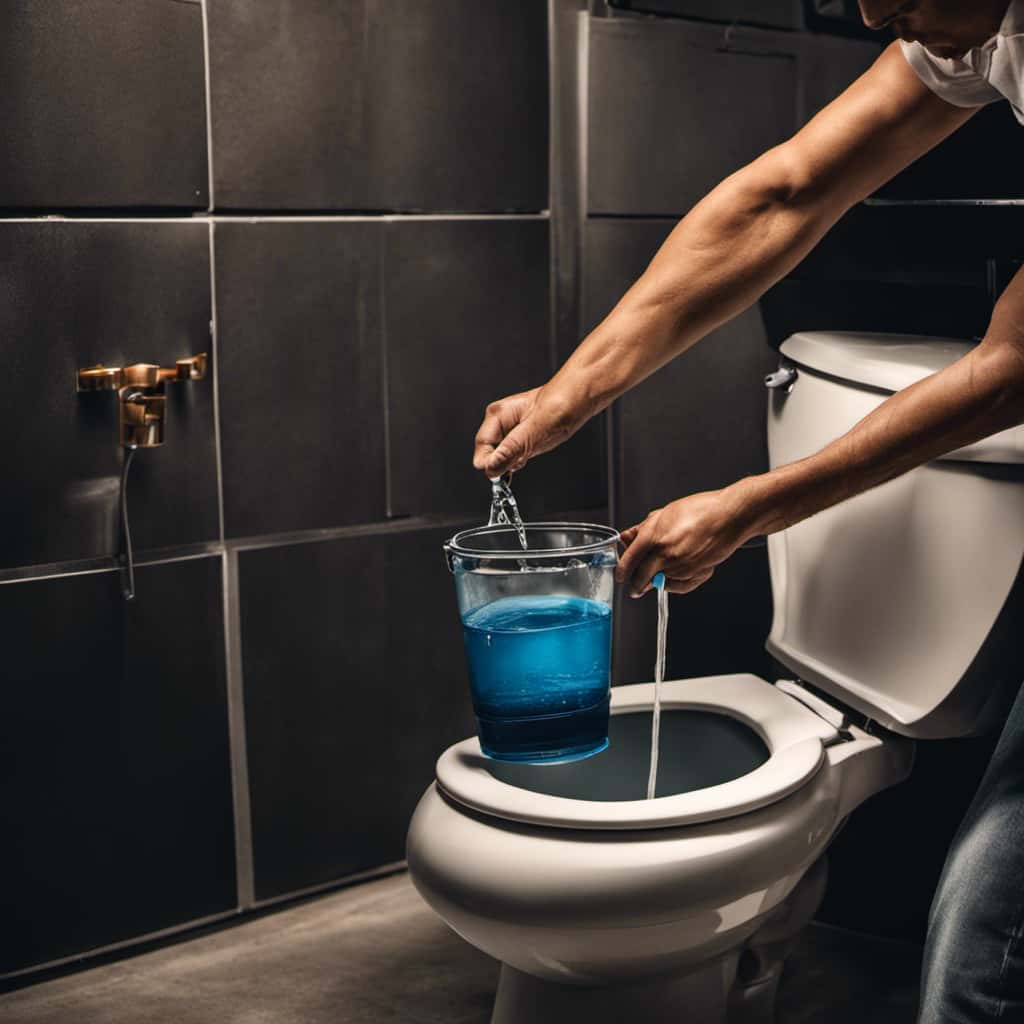
Similar to a ship’s crew discussing which way to navigate, we frequently contemplate the timeless query: should we shut the toilet seat after using it?
In this article, we explore the hygiene benefits, potential health risks, and courtesy arguments for closing the seat.
We also delve into the reasons why some opt to leave it open.
Join us as we navigate the murky waters of toilet seat etiquette and help you make an informed decision based on facts and considerations.
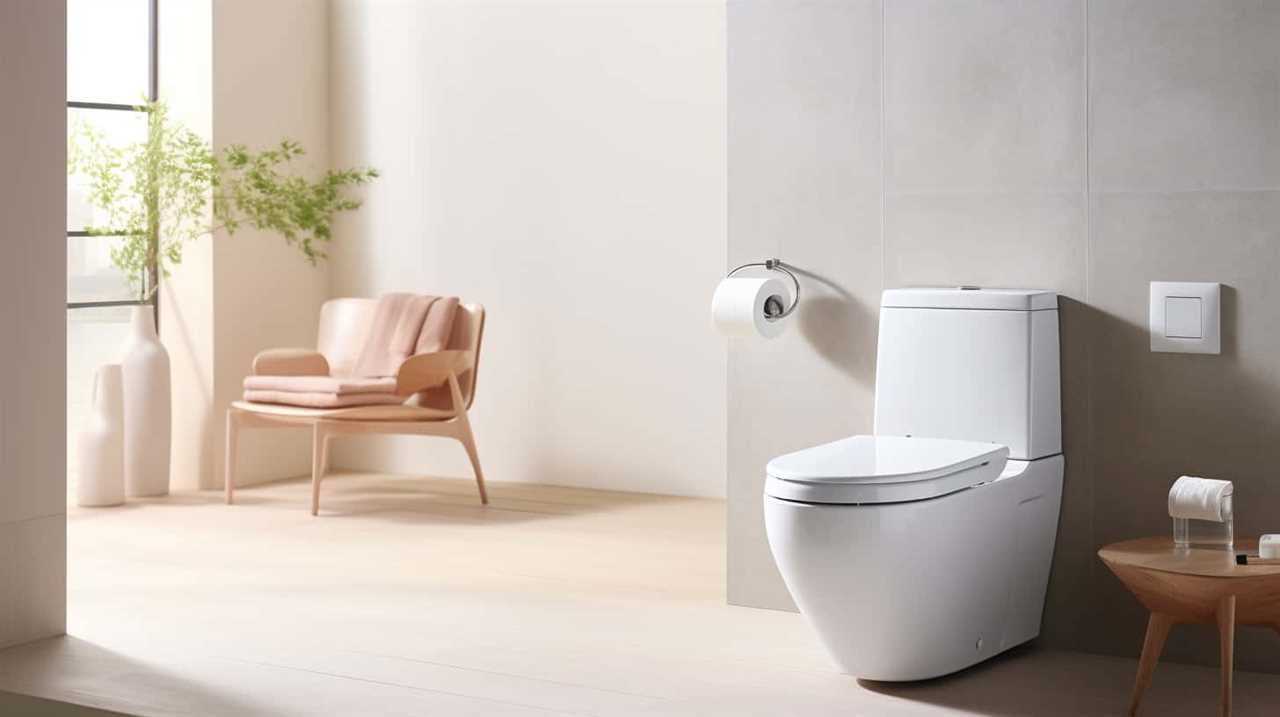
Key Takeaways
- Closing the toilet seat after pooping helps prevent the spread of germs and maintains cleanliness in the bathroom.
- Leaving the seat open increases the risk of spreading germs and bacteria throughout the bathroom, potentially causing illnesses.
- Closing the seat shows respect and consideration for others, preventing accidental contact with germs and reducing the risk of someone falling into the toilet bowl.
- When deciding whether to close the seat, it is important to consider personal preferences, household dynamics, and the importance of reaching a mutual agreement to maintain harmony in shared spaces.
Hygiene Benefits of Closing the Seat
Closing the toilet seat after using it can help prevent the spread of germs and maintain cleanliness in the bathroom. By closing the seat, you create a barrier that prevents bacteria and other microorganisms from escaping the toilet bowl and contaminating the surrounding area. This simple act of hygiene can significantly reduce the risk of illness and infection.
When the seat is left open, it allows for the dispersion of microscopic droplets that may contain harmful bacteria, increasing the chances of cross-contamination. Closing the toilet seat also prevents items from accidentally falling into the bowl, ensuring that the surface remains clean and free from potential sources of contamination.
Potential Health Risks of Leaving the Seat Open
Leaving the toilet seat open can increase the risk of spreading germs and bacteria throughout the bathroom. When the seat is left open, particles from flushing can be dispersed into the air, landing on various surfaces. These particles may contain harmful microorganisms that can cause illnesses such as diarrhea, urinary tract infections, and respiratory infections. To illustrate the potential health risks of leaving the seat open, consider the following table:
| Risks | Cleanliness |
|---|---|
| Spread of germs | Reduced hygiene |
| Increased infection | Decreased sanitation |
| Higher risk of illness | Poor bathroom hygiene |
The Courtesy Argument for Closing the Seat
After we finish using the toilet, it’s considerate to close the seat for the next person. This simple act shows respect and consideration for others who may need to use the bathroom after us. While some may argue that leaving the seat open isn’t a big deal, the courtesy argument for closing the seat holds its ground. Here are three reasons why closing the seat is the polite thing to do:
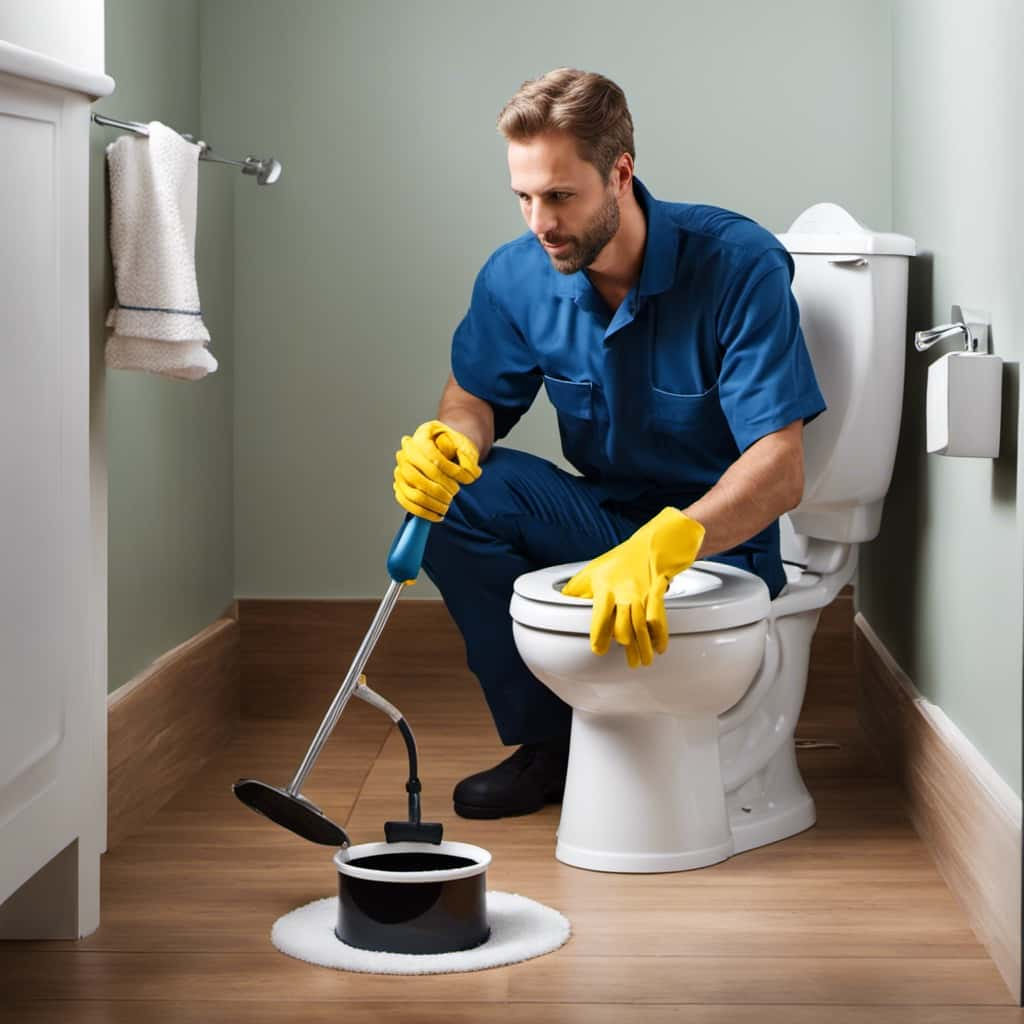
- Hygiene: Closing the seat prevents any accidental contact with germs or bacteria that may be present in the toilet bowl. It helps maintain a clean and sanitary environment for everyone.
- Safety: A closed seat reduces the risk of someone accidentally falling into the toilet bowl, especially in households with young children or elderly individuals.
- Cultural perspectives: Closing the seat is a common practice in many cultures, seen as a sign of cleanliness and respect. By adhering to this etiquette, we can show our understanding and consideration for diverse cultural norms.
Reasons Why Some People Choose to Leave the Seat Open
While it’s important to consider the courtesy argument for closing the seat, some people choose to leave it open for their own personal reasons. Toilet seat etiquette is a matter of individual preference, and there are several factors that might influence this choice.
Some individuals may have physical limitations or disabilities that make it difficult to close the seat after use. Others may find it more convenient to leave the seat open, especially in households where multiple people use the bathroom. Additionally, some individuals may have cultural or personal beliefs that affect their decision to leave the seat open.
Ultimately, each person’s choice regarding the toilet seat should be respected, as long as they’re mindful of the preferences and needs of others who share the same space.
Considerations for Making Your Own Decision
When making our own decision about whether to close the toilet seat after pooping, there are several factors to consider. Here are three key considerations to keep in mind:

- Toilet Seat Etiquette: Proper toilet seat etiquette is an important aspect to consider. Closing the toilet seat after using it shows respect for others who might use the bathroom next, ensuring a clean and tidy environment for everyone.
- Personal Preferences: Your own personal preferences should also play a role in making this decision. Some people prefer to close the toilet seat for hygienic reasons or to prevent pets from drinking out of the bowl, while others may leave it open for convenience or personal habits.
- Household Dynamics: The dynamics of your household can also influence your decision. If you live alone, you have the freedom to choose what works best for you. However, if you live with others, it’s important to consider their preferences and reach a mutual agreement to maintain harmony.
Frequently Asked Questions
Are There Any Specific Bacteria or Germs That Can Be Easily Transmitted From Leaving the Toilet Seat Open?
Leaving the toilet seat open can expose us to specific bacteria and germs that are easily transmitted. It’s important to close the toilet seat to minimize the risk of spreading these harmful microorganisms.
How Does Leaving the Toilet Seat Open Affect the Overall Cleanliness of the Bathroom?
Leaving the toilet seat open can have a negative effect on bathroom hygiene. It allows for the spread of bacteria and unpleasant odors to linger. Closing the seat after use helps maintain cleanliness and control odors.
Are There Any Potential Health Risks Associated With Closing the Toilet Seat After Pooping?
Closing the toilet seat after pooping may have potential hygiene risks. It can trap bacteria and odors, impacting bathroom sanitation. However, regularly cleaning the toilet and practicing good hand hygiene can help mitigate these risks.
What Are the Social Implications of Leaving the Toilet Seat Open in Public Restrooms?
When it comes to social etiquette in public restrooms, closing the toilet seat after use is considered good hygiene. It shows respect for others and helps maintain cleanliness, preventing potential health risks.
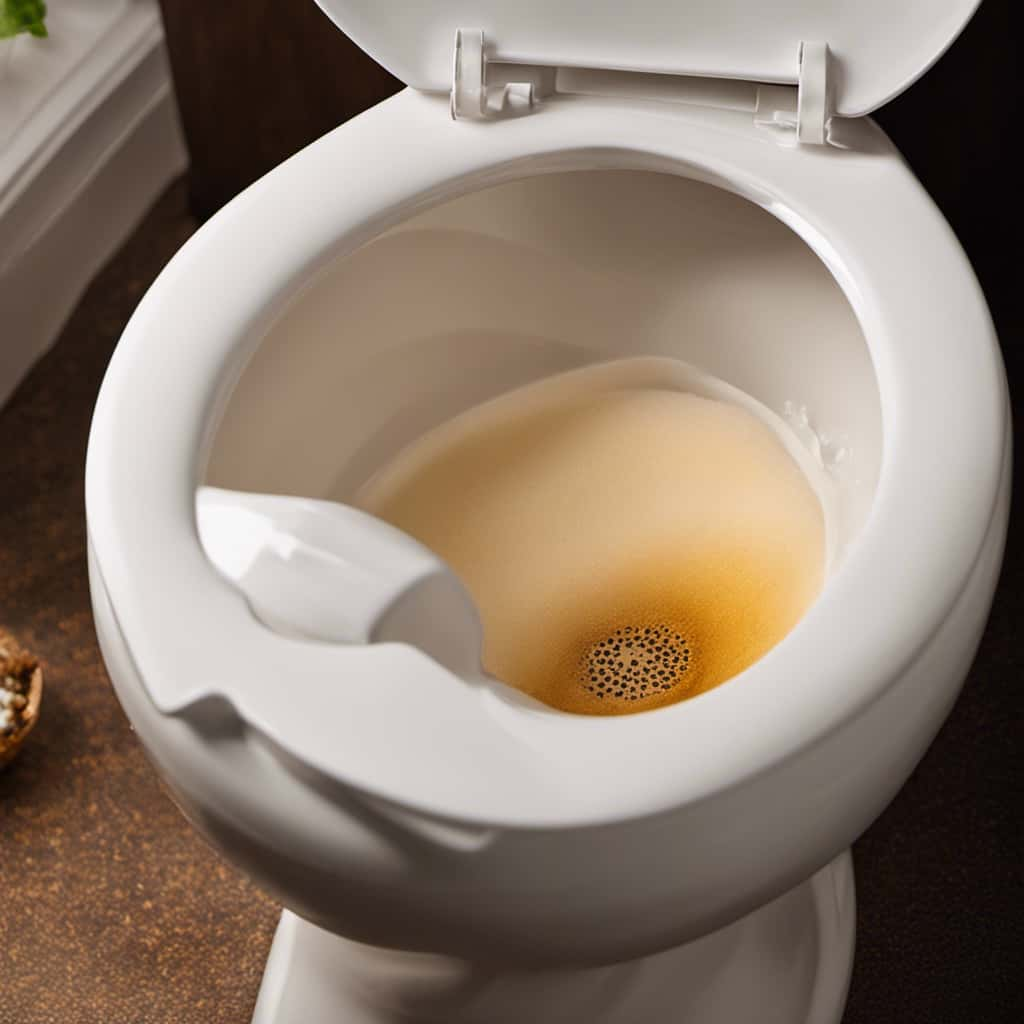
How Can Personal Preferences and Cultural Norms Influence the Decision to Close or Leave the Toilet Seat Open After Using the Bathroom?
When considering whether to close the toilet seat after using it, personal preferences and cultural norms play a significant role. Our individual choices and societal expectations shape our decision-making in this matter.
Conclusion
In conclusion, closing the toilet seat after pooping is a hygienic and considerate practice. It helps prevent the spread of germs and potential health risks associated with leaving it open.
Like closing the door to keep out unwanted guests, closing the toilet seat is a simple act of courtesy that can make a big difference in maintaining a clean and healthy bathroom environment.
So remember, just like shutting the front door to keep the cold out, close the toilet seat to keep the germs in!

With an impeccable eye for detail and a passion for bathroom-related, Ava leads our editorial team gracefully and precisely.
Under her guidance, Best Modern Toilet has flourished as the go-to resource for modern bathroom enthusiasts. In her free time, you might find Ava exploring antique shops and looking for vintage bathroom fixtures to add to her collection.
-

 Bathtub2 months ago
Bathtub2 months agoAre Clorox Toilet Wand Refills Septic Safe
-

 Reviews2 months ago
Reviews2 months agoLoupusuo Luxury Smart Toilet Review [2024]
-

 Reviews2 months ago
Reviews2 months agoSimple Project Modern Smart Toilet Review [2024]
-

 FAQ - Advanced Bathroom Queries2 months ago
FAQ - Advanced Bathroom Queries2 months agoWhat to Do if You Accidentally Flush a Paper Towel
-

 Reviews2 months ago
Reviews2 months agoLDian Smart Toilet Review: Luxury and Hygiene Combined [2024]
-

 Toilet Brands2 months ago
Toilet Brands2 months agoCan You Put Toilet Paper Down the Toilet in Cyprus
-

 FAQ - Advanced Bathroom Queries2 months ago
FAQ - Advanced Bathroom Queries2 months agoWhat to Do if a Toilet Paper Roll Gets Flushed Down the Toilet
-

 Reviews2 months ago
Reviews2 months agoWhich Is Better Flush Valve or Flush Tank























